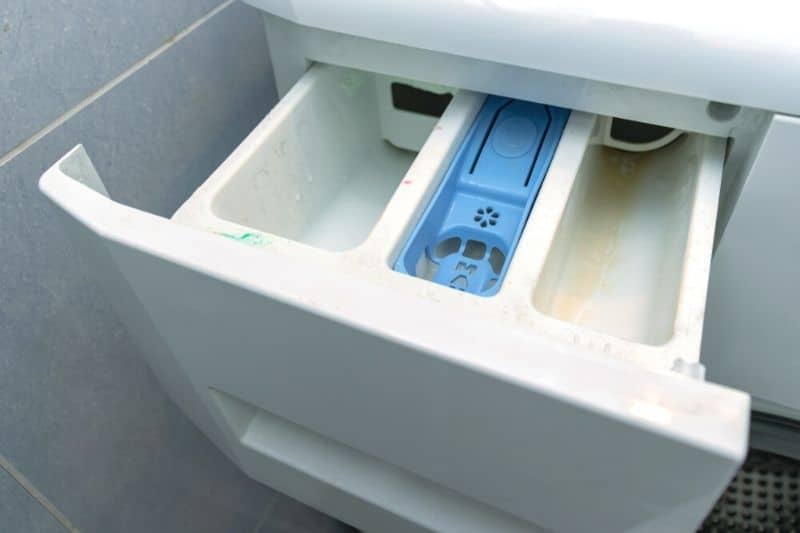Washing machines should smell fresh and clean, but there is a range of reasons as to why your machine could end up smelling like sewage or rotten eggs. This smell can stick to your clothing, and make the entire room smell damp too – pretty gross really.
Rather than stressing out wondering if your machine is past its use-by-date and should be replaced, you can easily work out what is causing the smell and how to deal with it swiftly.
What Causes the Smell?
The nature of a washing machine and the number of parts that can get wet, hold moisture, or allow for a build-up of grime means that there is a range of reasons that a washing machine can start to smell rotten.
The smell could come from the filter, heating elements, door seal, detergent drawer, hoses, drums or even the drain. So it’s essential to check all of these elements to completely get rid of any horrible niffy smells.
You might find that the cause could be one of the following things:
1. Bacteria
One of the most common reasons that a washing machine develops a rotten smell is a build-up of bacteria. Bacteria can build up in areas of the washing machine that aren’t easily accessible, making it tricky to identify which part of the washing machine is affected.
Low water temperatures just aren’t enough to eliminate bacteria. Whilst washing at low temperatures is much more eco-friendly, it does mean that machines can build up bacteria much quicker.
2. Detergent
Whilst it might sound counter-intuitive at first, one potential cause for a smelly washing machine is that you use too much detergent or fabric softener. If you use too much, the washing cycle might not manage to flush away all the detergent from inside the washing machine.
This can lead to a nasty smell, as detergent build-up provides an excellent place for bacteria to hide and mould to grow.
3. It’s due a clean
To keep them smelling fresh, washing machines should be cleaned regularly. Over the course of normal use, washing machines can end up with small items of clothing (i.e. socks), dirt, debris, insects and even coins trapped in various parts that can then cause blockages leading to nasty smells.
Cleaning the Washing Machine
Usually, it is possible for you to clean the machine yourself to deal with the smell without calling in professional help. However, if you cannot find the cause of the smell or just cannot shift it, it might be worth calling the washing machine’s technical team for tips or asking a plumber to come and have a look.
Service wash
Bacteria do not like high temperatures. It is recommended that you run a “service wash” once a month to keep the machine fresh. Run the washing machine empty at a high temperature to flush any bacteria or other nastiness out. You might find that your washing machine’s guide has instructions on how best to do this.
For added cleaning pow, add some white vinegar and bicarbonate of soda to the drawer – natural cleaning and deodorising in one go!
Soda crystals
When running a monthly cleaning cycle, it can help to run the cycle with soda crystals. Like with the standard service wash, run an empty hot wash with 500g of soda crystals in the main drum.
If you haven’t run this cycle before, or the machine smells worse or you see bits of black gunk after the cycle has finished, this means that the gunk has started to lift and just needs to be flushed away. Running a second soda crystal cycle will help!
Clean the seal
The washing machine’s seal is a magnet for grime, mould, mildew and bacteria. During a normal wash, this seal can collect hair, dirt, little pieces of fabric and a build-up of detergents or undissolved washing tablets too.
Cleaning the seal regularly will stop this from becoming a serious, smelly problem.
Clean the detergent drawer

The build-up of old detergent in the washing machine’s drawer can cause a nasty smell. Take out the drawer and any filters and clean them thoroughly to remove this build-up.
Using only the optimum amount of detergent going forwards will prevent this from accumulating quite as quickly. You can use natural cleaning agents such as white vinegar and bicarbonate of soda to make this easier.
After each cycle, tip away any remaining water/softener/detergent from the drawer, rinse through and leave it out to dry before replacing it. This will help reduce mould growth on the drawer and inside of the drawer compartment.
Scrub the drum
The grime that clings to clothing can stick to the inside of the drum rather than being washed away. To stop this from building up, scrub the inside of the drum once a month.
Stubborn stains can be dealt with by using a sponge that has been dipped in a mixture of white vinegar and water. Just be careful to avoid scratching the surface of the drum!
Unclog the drain
Drains are notorious for getting blocked. After a few months of regular use, a washing machine drain can very easily get blocked up. First, check the drain trap for anything that has gotten stuck.
The most common things that I’ve personally pulled out of a washing machine drain trap have been coins, hairpins and odd bits of plastic that have been caught in clothing, all of which can prevent a machine from draining properly and cause it to smell awful.
Check out our post here on what to do if your washing machine isn’t draining, as it has more detail on troubleshooting various pipes and drains linked with the washer.
If the problem is further down than the trap, fill a bucket with boiling water and bicarbonate of soda. Remove the drainpipe from the back of the machine and pour the hot water into the pipe through a funnel. Wait a few minutes and pour fresh water down to make sure it is draining properly.
Using a commercial washing machine drain unblocker is another way to make light work of this problem.
Ventilate
After you clean the machine, leave the main door and the detergent drawer open. This will allow air to circulate throughout the machine, helping it to dry naturally and prevent mould from building up. If the drawer is fully removable, leaving it to dry out in the sun can really help.
How to Stop the Smell Returning
A few washing machine best practices will help to stop the rotten egg smell from coming back. Always use the correct quantities of detergent for your machine and water hardness to stop detergent from building up in the machine.
Try to remove wet clothes as soon as the cycle has finished. Leaving the clothing to sit in the machine can cause the water to go stagnant, causing both the drum and the clothing to smell rotten. Unless the machine is a washer-dryer, you should remove the clothing within 15 minutes of the cycle finishing.
Avoid running the machine all day every day. Every now and again, try to leave the machine open to allow air to circulate. This will stop water from going stagnant, keep key parts dry and prevent the nasty sewer smell.
Using soda crystals alongside your detergent can help prevent limescale and dirt build-up on the inside of the machine.
If you live in a hard water area, adding soda crystals will also mean that you don’t need to use quite as much detergent to achieve the same results as soda crystals naturally soften the water.
If you live in a medium water area, add 25g of soda crystals to every wash, add 50g in a hard water area, and 75g in a very hard water area.
Check out our video all about smelly washing machines, what’s causing it and how to deal with it:

Lover of coffee, painting, and all things cute and fluffy. I’m always on the lookout for easier, more gentle ways to tackle awful household chores.






